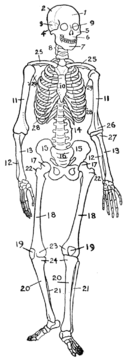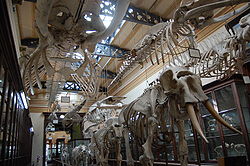- Osteology
-
Osteology is the scientific study of bones. A subdiscipline of anatomy, anthropology, and archeology, osteology is a detailed study of the structure of bones, skeletal elements, teeth, morphology, function, disease, pathology, the process of ossification (from cartilaginous molds), the resistance and hardness of bones (biophysics), etc. often used by scientists with identification of human remains with regard to age, death, sex, growth, and development in a biocultural context.
Contents
Methods
A typical analysis will include:
- an inventory of the skeletal elements present
- a dental inventory
- aging data, based upon epiphyseal fusion and dental eruption (for subadults) and deterioration of the pubic symphysis or sternal end of ribs (for adults)
- stature and other metric data
- ancestry
- non-metric traits
- pathology and/or cultural modifications
Applications
 Great Dane Skeleton Compared to a Chihuahua Skeleton at The Museum of Osteology, Oklahoma City, Oklahoma.
Great Dane Skeleton Compared to a Chihuahua Skeleton at The Museum of Osteology, Oklahoma City, Oklahoma.
Osteological approaches are frequently applied to investigations in disciplines such as forensic science, physical anthropology and archaeology, and has a place in research on topics including:
- health
- demography
- diet
- disease
- activity patterns
- physique
- genetics of early populations
- population migration
- Ancient warfare
- social inequality
- identification of unknown remains
- criminal investigations
- war crimes
See also
References
- Bass, W. M. 2005. Human Osteology: A Laboratory and Field Manual. 5th Edition. Columbia: Missouri Archaeological Society.
- Buikstra, J. E. and Ubelaker, D. H. (eds.) 1994. Standards for Data Collection from Human Skeletal Remains. Arkansas Archeological Survey Research Series No. 44.
- Cox, M and Mays, S. (eds.) 2000. Human Osteology in Archaeology and Forensic Science. London: Greenwich Medical Media.
External links
Categories:- Osteology
- Physical anthropology
- Musculoskeletal system stubs
- Anthropology stubs
Wikimedia Foundation. 2010.


